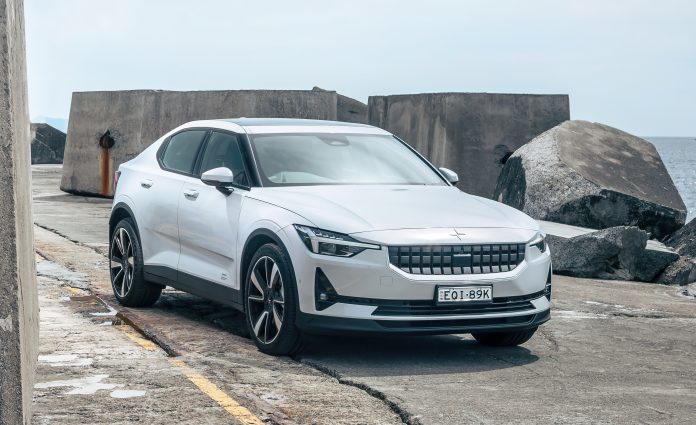Ray Cully our Motoring Editor checks out the Polestar 2
If you’ve never seen a car with a Polestar badge, you’re not alone. The Polestar brand was birthed from Polestar Racing, which was acquired by Volvo in 2015 to become its performance arm and allow motoring enthusiasts to purchase Polestar Performance enhanced variants directly from Volvo dealerships. With Polestar’s expertise in performance motoring and the integration of cutting-edge innovative technology, they are now positioned to focus on producing high-end performance electric vehicles under their own brand name.
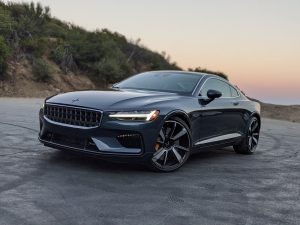
Polestar first flexed their engineering muscle and showcased a stunning concept vehicle, the Polestar 1, a sleek high-performance hybrid coupe offering a staggering 450kW of power and a chassis torturing 1000Nm of torque.
The Polestar 2 is their first fully electric vehicle (EV) and the competition should be looking anxious after the very positive response and praise Polestar has received for the three variants available for the Australian market. When choosing an EV, the first thing to wrap your head around is that model variants aren’t linked to engine size but are defined by battery capacity and number of electric motors. Of course, there are optional packs to customise your Polestar 2 to the right level of premium driver experience.
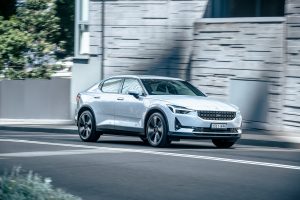
The standard base model is front wheel drive with a single motor. A usable battery capacity of 67kWh provides an indicated range of (WLTP) 470km or just under 18kWh/100k. Move up a level to the long-range variant and it’s a similar configuration other than the larger battery capacity of 75kWh, achieving a suggested range of (WLTP) 540km.
Like a traditional fossil-fueled car, many factors including outside temperature, AC, weight of right foot, number of passengers, luggage, and traffic conditions impact range. But with an EV, it seems likely that reality of average usage has yet to intersect with perfect test conditions. Over the week of the test drive, my gut suggested that 470km may be a tad optimistic for the base model.
The Polestar has a respectable 170kW and 330Nm of torque at the ready for overtaking or merging into freeway traffic. Whilst performance isn’t race car territory, it provides a crisp, effortless response to haul in the100kph mark at just a tad over seven seconds. So, unless you have the necessity to give your passengers whiplash by sinking the pedal to the metal on every take off (and quickly depleting your available range), then both these variants provide comfortable performance levels that probably exceed the average driver’s demands.
If a triple espresso is your first order of the day, then the long range with dual electric spinners will ease your fear of a lack of seat-embedding thrust. All Wheel Drive is required to harness the 300kW to avoid the tyres lighting up and smoking in public as you force feed 660Nm into the pavement. With your kidneys taking refuge behind your rib cage in a visceral sling shot, the needle frantically swings upward in an eerily silent rampage to reach 100kph in 4.7s (claimed).
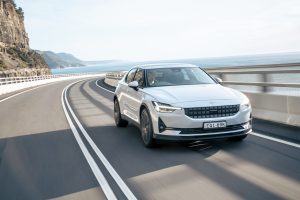
But don’t delude yourself by the title of “long range”. With twin electric motors, any gains you might have had with the larger battery evaporate far faster than the gratified smirk on your face. But who said electric couldn’t be fun?
In fact, your weekend won’t be ruined at all as you can even tow with the Polestar. With the highest towing capacity in its class, you can pull a braked payload of 1,500kg or 750kg unbraked. That should be enough for a small camper trailer or a couple of jet skis. Don’t panic, it’s ok to nod the tail toward the water as the battery and controls are well sealed and protected.
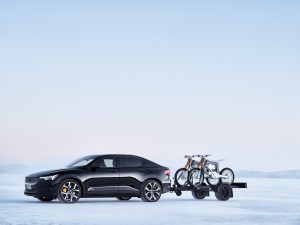
Personal styling is subjective. To me, the external aesthetics of EVs range from frumpy to elegant and everything in between as designers try to strike a balance between futuristic form to capture the imagination, and the necessity for real world practicality.
Working from a clean slate, rather than applying window dressing to an existing design, has advantages. From the rear, side, or front ¾ profile, the Polestar design team has delivered the goods. This five-door EV hatch back is an automotive styling statement with unique design elements that make it a crowd-pleasing people transporter.
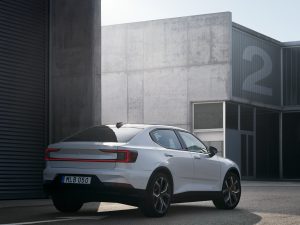
Sharp-dressed and up spec’d, the 20-inch alloys are wrapped in Continental 245/40R20 rubber. Futuristic elements include a rear tailgate LED light blade, high tech LED headlights and distinctive day time running lights that angle back and upwards to follow the curvature of the front wheel arches. Sculpted doors and a high waistline accentuate the flared rear guards; all working together in proportional harmony with the tapered roof profile and long wheelbase to give the Polestar 2 a sleek yet assertive stance. In short, it’s a car of subtle elegance and minimalist beauty and I don’t think it was just the unfamiliar name badge that generated so much interest from other drivers.
The cabin feels spacious and airy thanks in part to the full-length glass roof. With a Perth heatwave scorching everything to a crisp, I groaned at the thought of a daytime drive. But neither I, nor my fussy passenger, ever felt a sunburn sting or flush of heat from above.
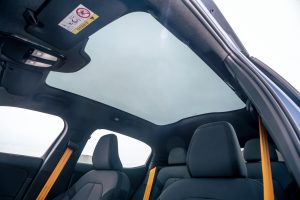
As you slide into the comfortable and ergonomically designed front driver’s seat, your immediate impression is one of European quality. The bespoke multilayered dash design, pleasing attention to detail, and wonderful tactile surfaces clearly reflect this vehicle’s prestigious Gothenburg lineage. There are subtle Volvo elements throughout the cabin, as the two companies share a synergy for advanced engineering design and technology to improve economies of scale. Our test vehicle included the optional plus pack, which incorporated an array of features as listed below, one being the superb 600W 13-speaker Harman Kardon audio system; and Spotify sounded fabulous!
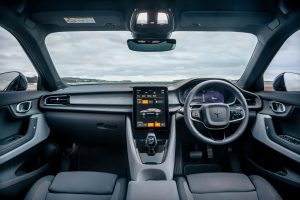
Front and center of the dash is a large portrait-orientated 11.1-inch touch screen, which runs Android Automotive OS developed with Google. It’s always connected and always up to date… nice! There’s Google Assistant, Google Maps with natural voice commands and the system can operate independently of your mobile phone or you can connect Android, iPhone, and other devices via Bluetooth. A 15-watt inductive phone charger is conveniently placed below the screen in the center console, along with dual USB ports.
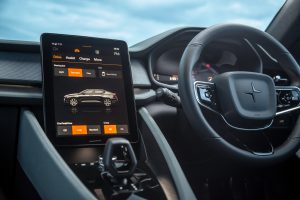
I was pleased to find I could instantly use the system. If you’ve used Google apps on your phone or a computer… it’s the same. I love intuitive systems with no fumbling with manuals or trying to remember commands and totally Luddite friendly.
And it delighted me that Polestar not only retained a driver information display in the traditional dashboard location but made it extremely useful. It provides access to menus for individual customisation of various vehicle settings, can be configured for a range of information and offered the best map overlay option my wife has ever seen. There were other niceties like heated front and rear seats and steering wheel, electric adjustment on the front seats, tinted rear window and a rear cargo lid-in-lid design with bag holder.
The other standout for me was the vegan interior. Polestar calls it “Weave Tech”. The soft grey finish is not only lighter and more durable than leather, but it’s very comfortable and completely recyclable, accented with black ash trim. I found myself questioning why anyone would choose the leather option. Given Polestar’s design ethos shows a strong commitment to sustainability and a cleaner environment for future generations, they’ve won my vote.
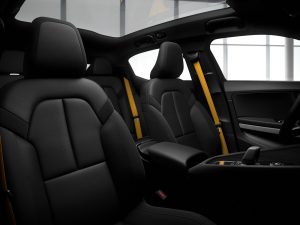
Rear seat space is comfortable and, even sitting behind a giraffe, you’re not cut off at the knees. The sloping roof line might be a little cozy for those over 182cms, but it’s a comfortable space to spend time. The fact that the rear windows only go halfway down was perplexing—maybe it was something I was doing wrong?
There’s an unexpected transmission tunnel down the centre, as opposed to a flat back floor. But Polestar has utilised that otherwise wasted space for battery placement, while allowing for proper foot wells in the rear, which improves passenger comfort (unless you’re the less fortunate third sibling). Storage is adequate. There’s the obligatory glove box and door pockets for drink bottles, but the center console is odd. There are two cup holders with one located under an arm rest. Slide forward the arm rest and it cuts off the room for the second cup—go figure.
The rear floor space behind the second row is respectable at 405L, drop the seats and that jumps to 1,095L. You can key, touch or foot wave under the vehicle to open the to reveal a nice wide opening that’s easy for loading the IKEA haul. Given hooks and tie down points, even a ski door in the back seats (probably better suited for their Nordic market) and they may have thought of everything.
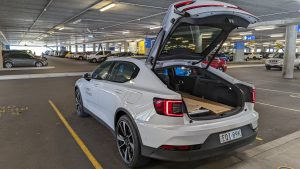
But move round the front to pop the hood and, given the lack of a traditional engine, the absence of any practical storage under the bonnet may be a surprise. It’s just a shallow recess suitable for the mains charging cable and not much else.
While it feels weird to have no key or push button start, activating the Polestar couldn’t be easier. As long as you have the proximity fob in your pocket or console, place your foot firmly on the brake, click on your seatbelt and push the gear lever forward for reverse or pull back for drive. Depress the accelerator and glide effortlessly away.
At first, the quietness of Polestar as you accelerate up to speed feels a little surreal, but trust me, you’ll adapt to it so quickly that in a day or so, you won’t give it a second thought. The only thing to be heard is tyre noise if the road is less than perfect and a little wind noise. I did really like the borderless wing mirrors and how the housing moves, instead of the inner glass, as you make adjustments.
With only forward and reverse, there is little to worry about other than enjoying the ride. Electric motors have it all over fossil fuel combustion engines as they deliver maximum available torque from the get-go—translating into rapid acceleration, to which I’m rather addicted even though I don’t drive a dragster around town.
However, the Polestar 2’s slow response to throttle input seems initially odd. Given that electric motors are very responsive, the Polestar feels a little lethargic to get moving. I understand the rationale is to avoid unwitting drivers launching into the car in front, but a simple touch screen option to adjust throttle sensitivity would be nice, something similar to the level settings of regenerative braking applied during deceleration.
One feature that initially had me feeling nauseous was the weird sensation of one pedal operation. It allows you to control acceleration, speed and braking with just the throttle. Press the throttle to move, lift the throttle and the regenerative braking slows the vehicle. There are three settings, the first applying the strongest regenerative braking and the second for medium. Switch it off, and you need to use the brake pedal as normal.
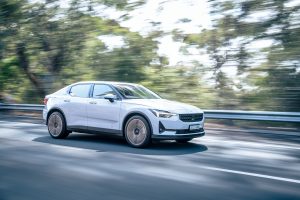
Initially, I was constantly rocking backward and forward in my seat as I learnt to finesse my throttle control. Take the time to get used to it and it’s the duck’s pajamas. I could approach a corner, slow down, move through the corner and throttle out in one seamless, smooth motion. Oh, and don’t get me started on how good it is in stop-start freeway traffic. Even my wife commented on the significant improvement in the smoothness of my driving. How rude!
As an enjoyable, comfortable EV, the Polestar’s lower center of gravity and roll center means its deceptively flat through corners, with responsive electric torque on tap for more fun when exiting the bend which combine to provide an engaging drive. Rather than a sports car, it’s a nice 5-door hatch with a playful side. A high level of torsional rigidity allowed Polestar to work their magic on the MacPherson front end and multi-link rear end to achieve confident handling.
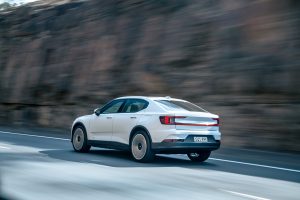
Safety features are a mixed bag of standard and optional. Yes, there’s a full 5-star ANCAP safety rating so you can tick that check box. More standard features include eight airbags, dual frontal, side chest and head protection with curtain airbags and a centre airbag which provides added protection to front seat occupants in side impact crashes. There’s a steel safety cage, battery protection, an impact deflecting brace/bracket to protect the occupant compartment on impact called SPOC Block, plus frontal protection to mimic the critical energy-absorbing characteristics of having an engine up front.
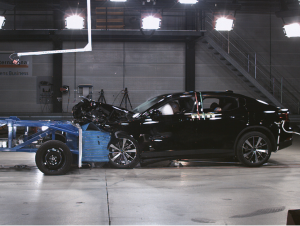
There’s also autonomous emergency breaking (AEB) for vehicles, pedestrians and cyclists, day or night; lane keep aid, oncoming lane or run-off-the-road mitigation and driver alert for signs of drowsiness or fatigue.
But features such as blind spot monitoring, 360-degree cameras, cross traffic alert, rear collision warning or adaptive cruise control are extras found in the optional Pilot Lite pack for an additional $3,400. Which doesn’t stack neatly against other manufacturers who include them as standard. However, you can spin that as a negative or positive. Rather than pay a higher cost upfront and call everything standard, Polestar are providing the flexibility for customers to choose how and where they spend their money based on what’s important to them. If you want all the bells and whistles, that’s your choice to make.
For those who want more spark, Polestar also offers an $8,000 performance pack for the dual motor variant consisting of 20-inch wheels, lower profile tyres, a performance Brembo brake package, and the essential, gold-painted brake calipers, valve caps and seat belts. Plus, you get manually adjustable dampers. Really? For a vehicle with high tech features, what happened to touch screen comfort or a dial for sport selection? Who’s going to appreciate that they’ll have to lie on the ground every time they want to make a change to their dampers for ride comfort or control?
The last critical question… how long does it take to re-charge? For our single motor, long range test vehicle, Polestar indicates:
- Standard outlet: 1-phase AC 16A up to 24 hours for 0-100% charge
- Wall-box: 3-phase AC 16A up to 8 hours for 0-100% charge
- Public fast charger: DC as little as 35 minutes for 10-80% charge
For their first foray into the market, Polestar should be commended for successfully delivering on their design brief. The Polestar 2 is a well-crafted execution of what can be achieved when manufacturers get creative with solutions to futuristic challenges. Smooth, quiet, functional, environmentally responsible with stylish good looks, I liked it and it’s hard not to want one.

So, am I signing up for the EV revolution? The Polestar 2 is a pleasure to drive and very easy to live with, even after the novelty of silent driving wears off. But a sleek road-going EV will not cut it for me! I’m hanging out for those clever engineers to deliver even longer-range battery capacity and solar charging tech wizardry so I can get my hands on a 4WDrive EV with good ground clearance, long wheel travel, rugged tyres and mountains of torque to negate the need for a low range transfer case. Don’t laugh, it will happen, just not overnight!
Fast Facts:
Base Price: $64,900
Model: Polestar 2 Long Range Single EM.
Engine: Single Permanent Magnet Electric Motor
Output: 170kW/330Nm
Battery Capacity 78kWh
Energy Consumption: 18.0 kWh / 100km
Suggested Range: Up to 540 km (WLTP)
Safety Rating ANCAP 5 Stars.
Optional Packs as tested:
Plus Pack + $6,000:
Heat pump
Fixed panoramic sunroof including projected Polestar symbol
Harman Kardon Premium Sound
WeaveTech (Charcoal or Slate) seats with Black Ash decor inlays
Full power seats including 4-way power lumbar support (memory on driver seat), manual cushion extension and backrest storage nets
Heated rear seat and steering wheel, and washer fluid nozzles
Interior high-level illumination
Inductive charging 15W for smart phone
Grocery bag holder
Pilot lite + $3.400
LED front fog lights
360° camera
Driver assistance with Pilot Assist, Adaptive Cruise Control, and Emergency Stop Assist
Driver awareness with Blind Spot Information System (BLIS) with steering assist, Cross Traffic Alert with brake support, and Rear Collision Warning & Mitigation
Automatically dimmed exterior mirrors
Park Assist side















